Employment Law Report: Legal System, Contracts and Workers' Rights
VerifiedAdded on 2022/12/30
|29
|7965
|1
Report
AI Summary
This report provides a comprehensive overview of employment law, encompassing various critical aspects. It begins by explaining the aims and objectives of employment regulation, emphasizing fairness, compliance with international obligations, and the protection of employees. The report then details the roles of tribunals and courts in enforcing employment law, including alternative dispute resolution methods like arbitration, mediation, and conciliation. It further explores the principles of discrimination law during recruitment, selection, and employment, followed by an explanation of how contracts of employment are established and lawfully changed. The report also covers redundancy law, business transfers, and major statutory rights related to pay, leave, working time, and equal pay. Additionally, it discusses maternity, paternity, family-friendly rights, health and safety law, implied duties, and freedom of association. Finally, the report examines the main requirements of unfair dismissal law, focusing on capability and misconduct issues, and the right to accompaniment at disciplinary hearings.

5EML
Unit: 5EML
Unit: 5EML
Paraphrase This Document
Need a fresh take? Get an instant paraphrase of this document with our AI Paraphraser
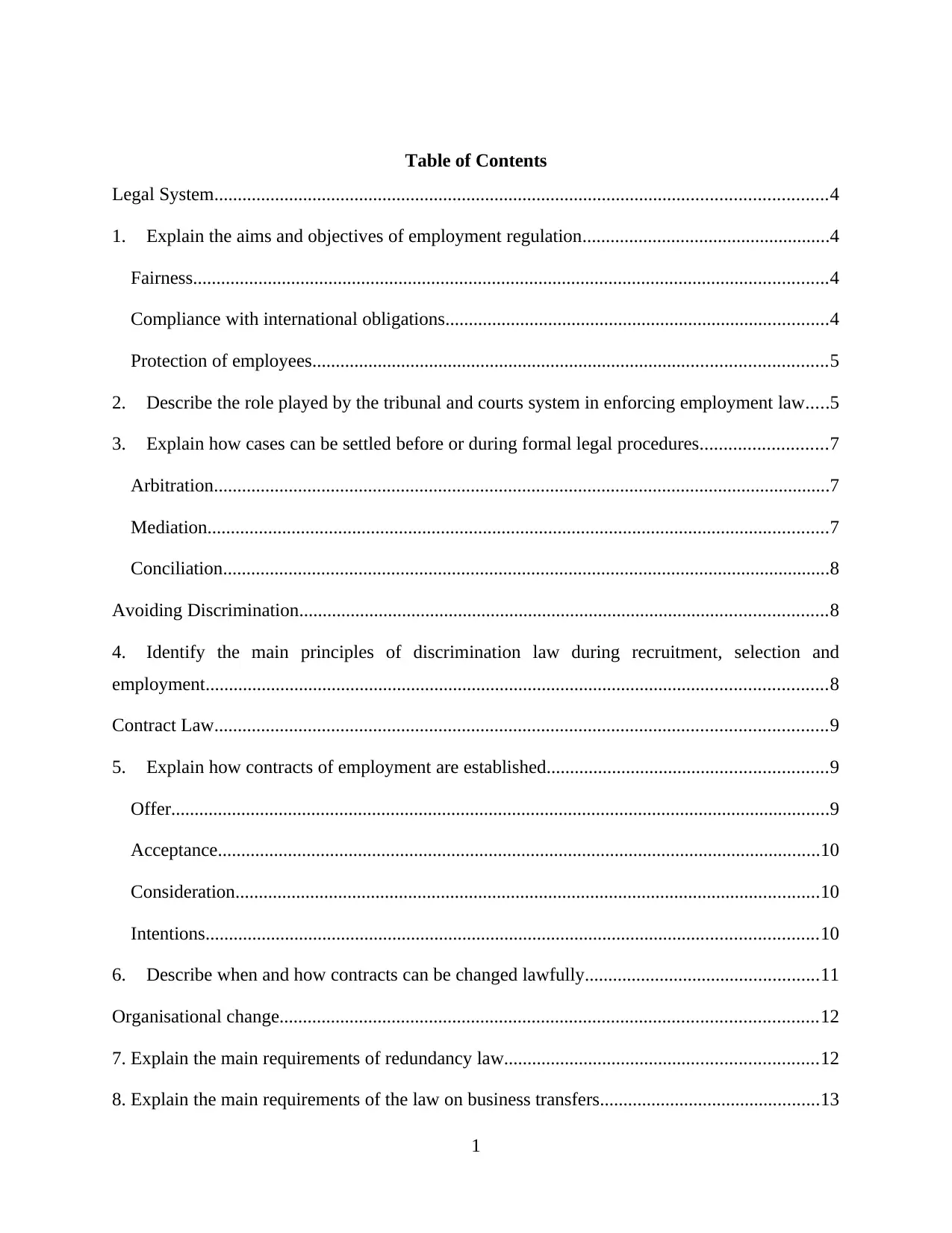
Table of Contents
Legal System...................................................................................................................................4
1. Explain the aims and objectives of employment regulation.....................................................4
Fairness........................................................................................................................................4
Compliance with international obligations..................................................................................4
Protection of employees..............................................................................................................5
2. Describe the role played by the tribunal and courts system in enforcing employment law.....5
3. Explain how cases can be settled before or during formal legal procedures...........................7
Arbitration....................................................................................................................................7
Mediation.....................................................................................................................................7
Conciliation..................................................................................................................................8
Avoiding Discrimination.................................................................................................................8
4. Identify the main principles of discrimination law during recruitment, selection and
employment.....................................................................................................................................8
Contract Law...................................................................................................................................9
5. Explain how contracts of employment are established............................................................9
Offer.............................................................................................................................................9
Acceptance.................................................................................................................................10
Consideration.............................................................................................................................10
Intentions...................................................................................................................................10
6. Describe when and how contracts can be changed lawfully..................................................11
Organisational change...................................................................................................................12
7. Explain the main requirements of redundancy law...................................................................12
8. Explain the main requirements of the law on business transfers...............................................13
1
Legal System...................................................................................................................................4
1. Explain the aims and objectives of employment regulation.....................................................4
Fairness........................................................................................................................................4
Compliance with international obligations..................................................................................4
Protection of employees..............................................................................................................5
2. Describe the role played by the tribunal and courts system in enforcing employment law.....5
3. Explain how cases can be settled before or during formal legal procedures...........................7
Arbitration....................................................................................................................................7
Mediation.....................................................................................................................................7
Conciliation..................................................................................................................................8
Avoiding Discrimination.................................................................................................................8
4. Identify the main principles of discrimination law during recruitment, selection and
employment.....................................................................................................................................8
Contract Law...................................................................................................................................9
5. Explain how contracts of employment are established............................................................9
Offer.............................................................................................................................................9
Acceptance.................................................................................................................................10
Consideration.............................................................................................................................10
Intentions...................................................................................................................................10
6. Describe when and how contracts can be changed lawfully..................................................11
Organisational change...................................................................................................................12
7. Explain the main requirements of redundancy law...................................................................12
8. Explain the main requirements of the law on business transfers...............................................13
1
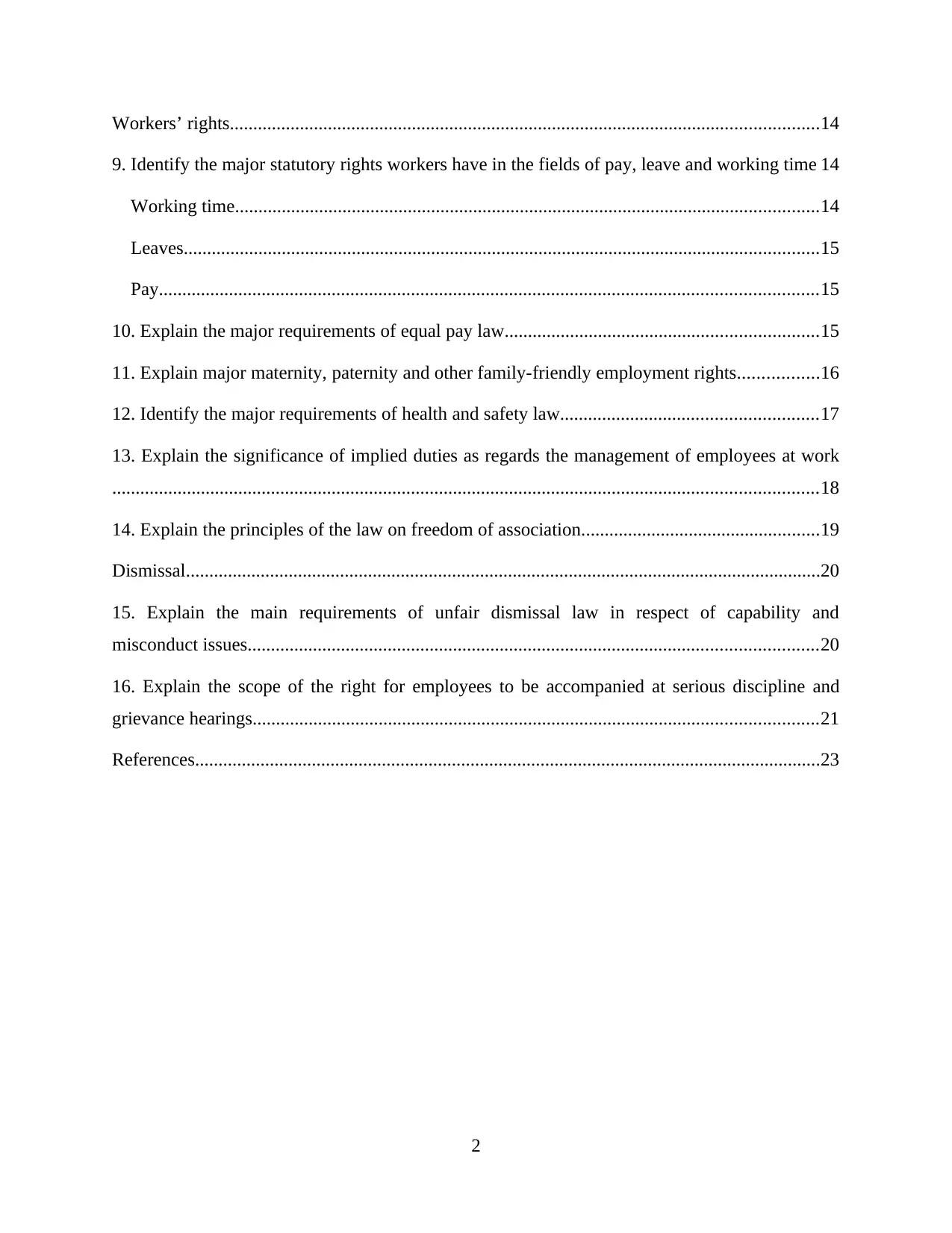
Workers’ rights..............................................................................................................................14
9. Identify the major statutory rights workers have in the fields of pay, leave and working time 14
Working time.............................................................................................................................14
Leaves........................................................................................................................................15
Pay.............................................................................................................................................15
10. Explain the major requirements of equal pay law...................................................................15
11. Explain major maternity, paternity and other family-friendly employment rights.................16
12. Identify the major requirements of health and safety law.......................................................17
13. Explain the significance of implied duties as regards the management of employees at work
.......................................................................................................................................................18
14. Explain the principles of the law on freedom of association...................................................19
Dismissal........................................................................................................................................20
15. Explain the main requirements of unfair dismissal law in respect of capability and
misconduct issues..........................................................................................................................20
16. Explain the scope of the right for employees to be accompanied at serious discipline and
grievance hearings.........................................................................................................................21
References......................................................................................................................................23
2
9. Identify the major statutory rights workers have in the fields of pay, leave and working time 14
Working time.............................................................................................................................14
Leaves........................................................................................................................................15
Pay.............................................................................................................................................15
10. Explain the major requirements of equal pay law...................................................................15
11. Explain major maternity, paternity and other family-friendly employment rights.................16
12. Identify the major requirements of health and safety law.......................................................17
13. Explain the significance of implied duties as regards the management of employees at work
.......................................................................................................................................................18
14. Explain the principles of the law on freedom of association...................................................19
Dismissal........................................................................................................................................20
15. Explain the main requirements of unfair dismissal law in respect of capability and
misconduct issues..........................................................................................................................20
16. Explain the scope of the right for employees to be accompanied at serious discipline and
grievance hearings.........................................................................................................................21
References......................................................................................................................................23
2
⊘ This is a preview!⊘
Do you want full access?
Subscribe today to unlock all pages.

Trusted by 1+ million students worldwide
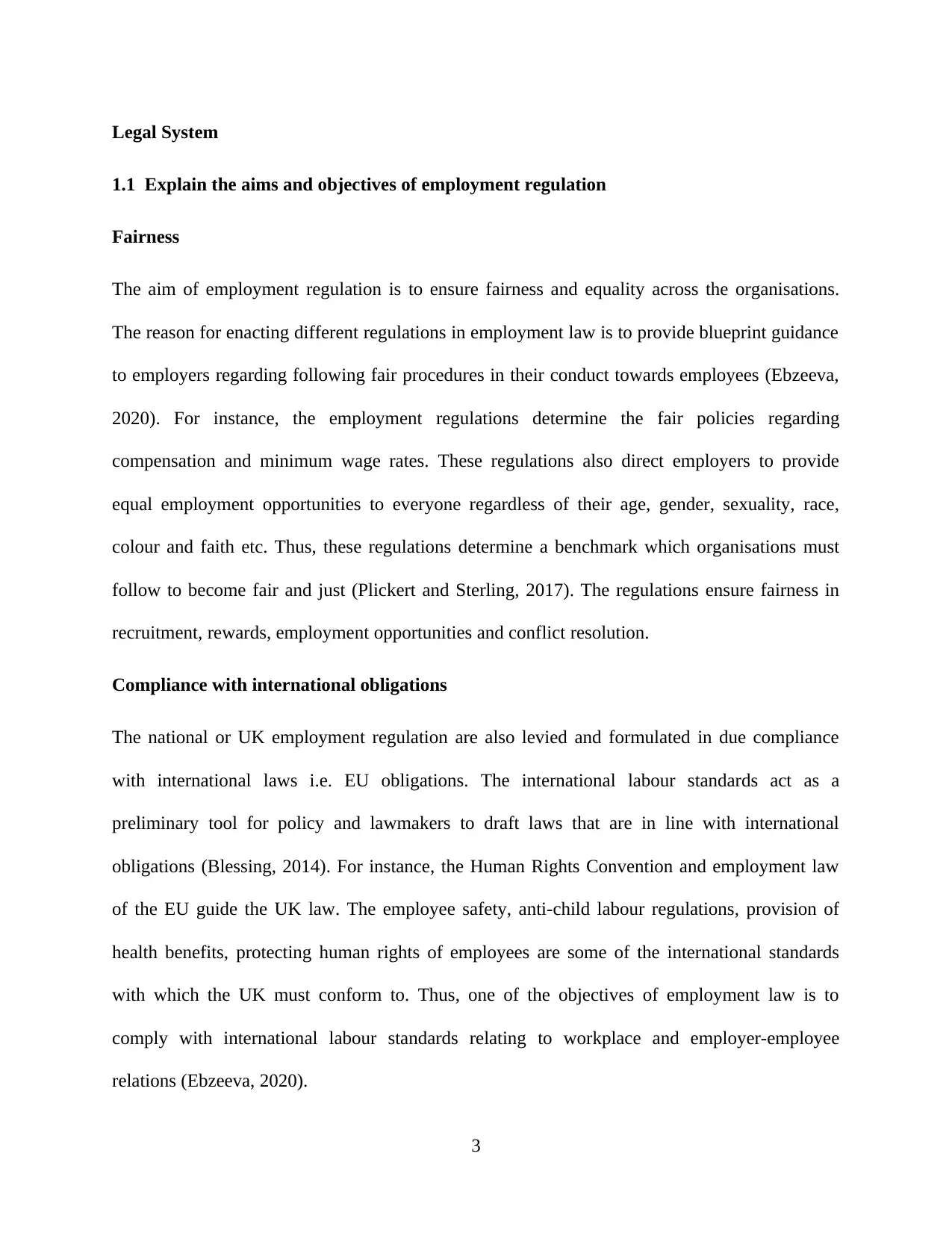
Legal System
1.1 Explain the aims and objectives of employment regulation
Fairness
The aim of employment regulation is to ensure fairness and equality across the organisations.
The reason for enacting different regulations in employment law is to provide blueprint guidance
to employers regarding following fair procedures in their conduct towards employees (Ebzeeva,
2020). For instance, the employment regulations determine the fair policies regarding
compensation and minimum wage rates. These regulations also direct employers to provide
equal employment opportunities to everyone regardless of their age, gender, sexuality, race,
colour and faith etc. Thus, these regulations determine a benchmark which organisations must
follow to become fair and just (Plickert and Sterling, 2017). The regulations ensure fairness in
recruitment, rewards, employment opportunities and conflict resolution.
Compliance with international obligations
The national or UK employment regulation are also levied and formulated in due compliance
with international laws i.e. EU obligations. The international labour standards act as a
preliminary tool for policy and lawmakers to draft laws that are in line with international
obligations (Blessing, 2014). For instance, the Human Rights Convention and employment law
of the EU guide the UK law. The employee safety, anti-child labour regulations, provision of
health benefits, protecting human rights of employees are some of the international standards
with which the UK must conform to. Thus, one of the objectives of employment law is to
comply with international labour standards relating to workplace and employer-employee
relations (Ebzeeva, 2020).
3
1.1 Explain the aims and objectives of employment regulation
Fairness
The aim of employment regulation is to ensure fairness and equality across the organisations.
The reason for enacting different regulations in employment law is to provide blueprint guidance
to employers regarding following fair procedures in their conduct towards employees (Ebzeeva,
2020). For instance, the employment regulations determine the fair policies regarding
compensation and minimum wage rates. These regulations also direct employers to provide
equal employment opportunities to everyone regardless of their age, gender, sexuality, race,
colour and faith etc. Thus, these regulations determine a benchmark which organisations must
follow to become fair and just (Plickert and Sterling, 2017). The regulations ensure fairness in
recruitment, rewards, employment opportunities and conflict resolution.
Compliance with international obligations
The national or UK employment regulation are also levied and formulated in due compliance
with international laws i.e. EU obligations. The international labour standards act as a
preliminary tool for policy and lawmakers to draft laws that are in line with international
obligations (Blessing, 2014). For instance, the Human Rights Convention and employment law
of the EU guide the UK law. The employee safety, anti-child labour regulations, provision of
health benefits, protecting human rights of employees are some of the international standards
with which the UK must conform to. Thus, one of the objectives of employment law is to
comply with international labour standards relating to workplace and employer-employee
relations (Ebzeeva, 2020).
3
Paraphrase This Document
Need a fresh take? Get an instant paraphrase of this document with our AI Paraphraser
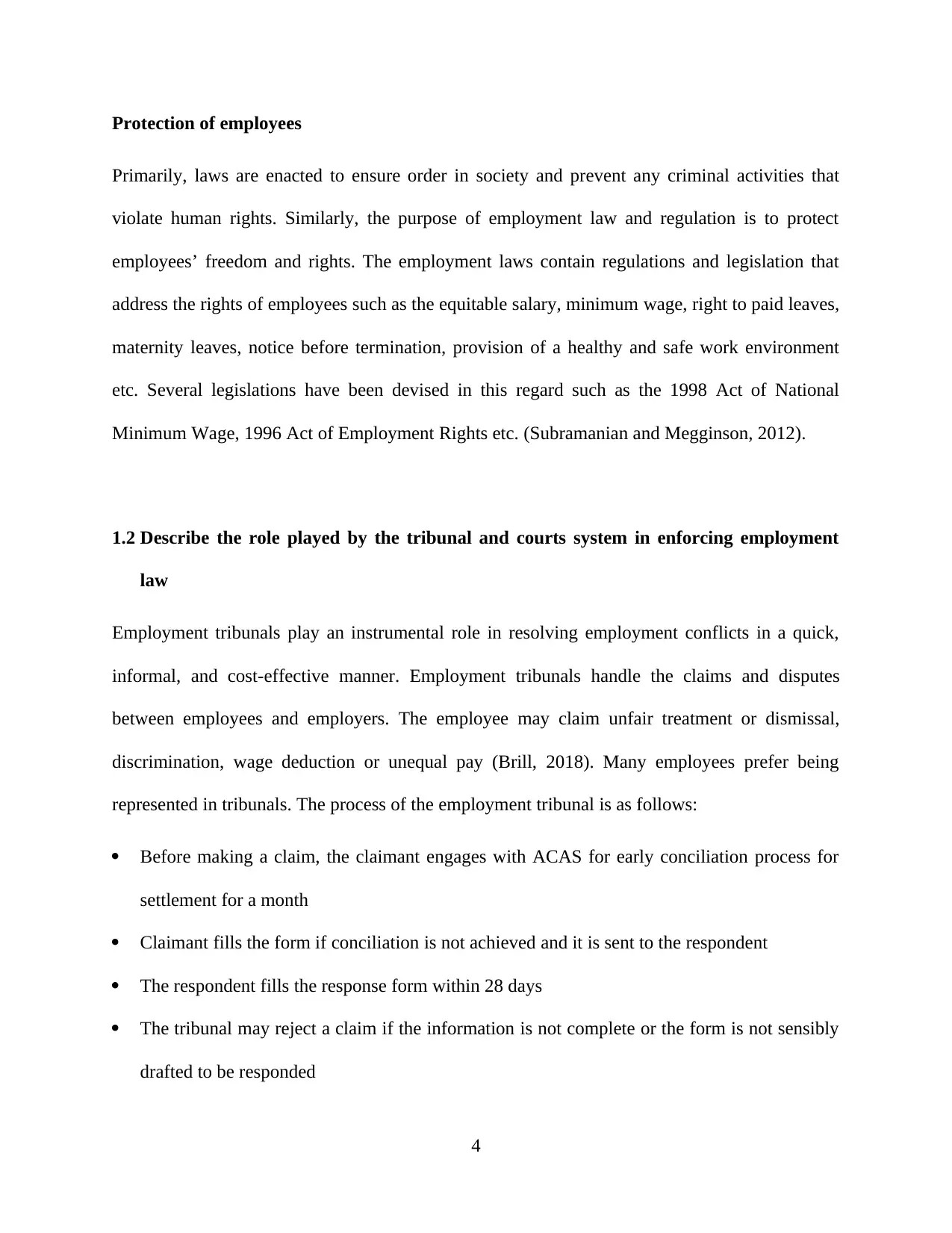
Protection of employees
Primarily, laws are enacted to ensure order in society and prevent any criminal activities that
violate human rights. Similarly, the purpose of employment law and regulation is to protect
employees’ freedom and rights. The employment laws contain regulations and legislation that
address the rights of employees such as the equitable salary, minimum wage, right to paid leaves,
maternity leaves, notice before termination, provision of a healthy and safe work environment
etc. Several legislations have been devised in this regard such as the 1998 Act of National
Minimum Wage, 1996 Act of Employment Rights etc. (Subramanian and Megginson, 2012).
1.2 Describe the role played by the tribunal and courts system in enforcing employment
law
Employment tribunals play an instrumental role in resolving employment conflicts in a quick,
informal, and cost-effective manner. Employment tribunals handle the claims and disputes
between employees and employers. The employee may claim unfair treatment or dismissal,
discrimination, wage deduction or unequal pay (Brill, 2018). Many employees prefer being
represented in tribunals. The process of the employment tribunal is as follows:
Before making a claim, the claimant engages with ACAS for early conciliation process for
settlement for a month
Claimant fills the form if conciliation is not achieved and it is sent to the respondent
The respondent fills the response form within 28 days
The tribunal may reject a claim if the information is not complete or the form is not sensibly
drafted to be responded
4
Primarily, laws are enacted to ensure order in society and prevent any criminal activities that
violate human rights. Similarly, the purpose of employment law and regulation is to protect
employees’ freedom and rights. The employment laws contain regulations and legislation that
address the rights of employees such as the equitable salary, minimum wage, right to paid leaves,
maternity leaves, notice before termination, provision of a healthy and safe work environment
etc. Several legislations have been devised in this regard such as the 1998 Act of National
Minimum Wage, 1996 Act of Employment Rights etc. (Subramanian and Megginson, 2012).
1.2 Describe the role played by the tribunal and courts system in enforcing employment
law
Employment tribunals play an instrumental role in resolving employment conflicts in a quick,
informal, and cost-effective manner. Employment tribunals handle the claims and disputes
between employees and employers. The employee may claim unfair treatment or dismissal,
discrimination, wage deduction or unequal pay (Brill, 2018). Many employees prefer being
represented in tribunals. The process of the employment tribunal is as follows:
Before making a claim, the claimant engages with ACAS for early conciliation process for
settlement for a month
Claimant fills the form if conciliation is not achieved and it is sent to the respondent
The respondent fills the response form within 28 days
The tribunal may reject a claim if the information is not complete or the form is not sensibly
drafted to be responded
4
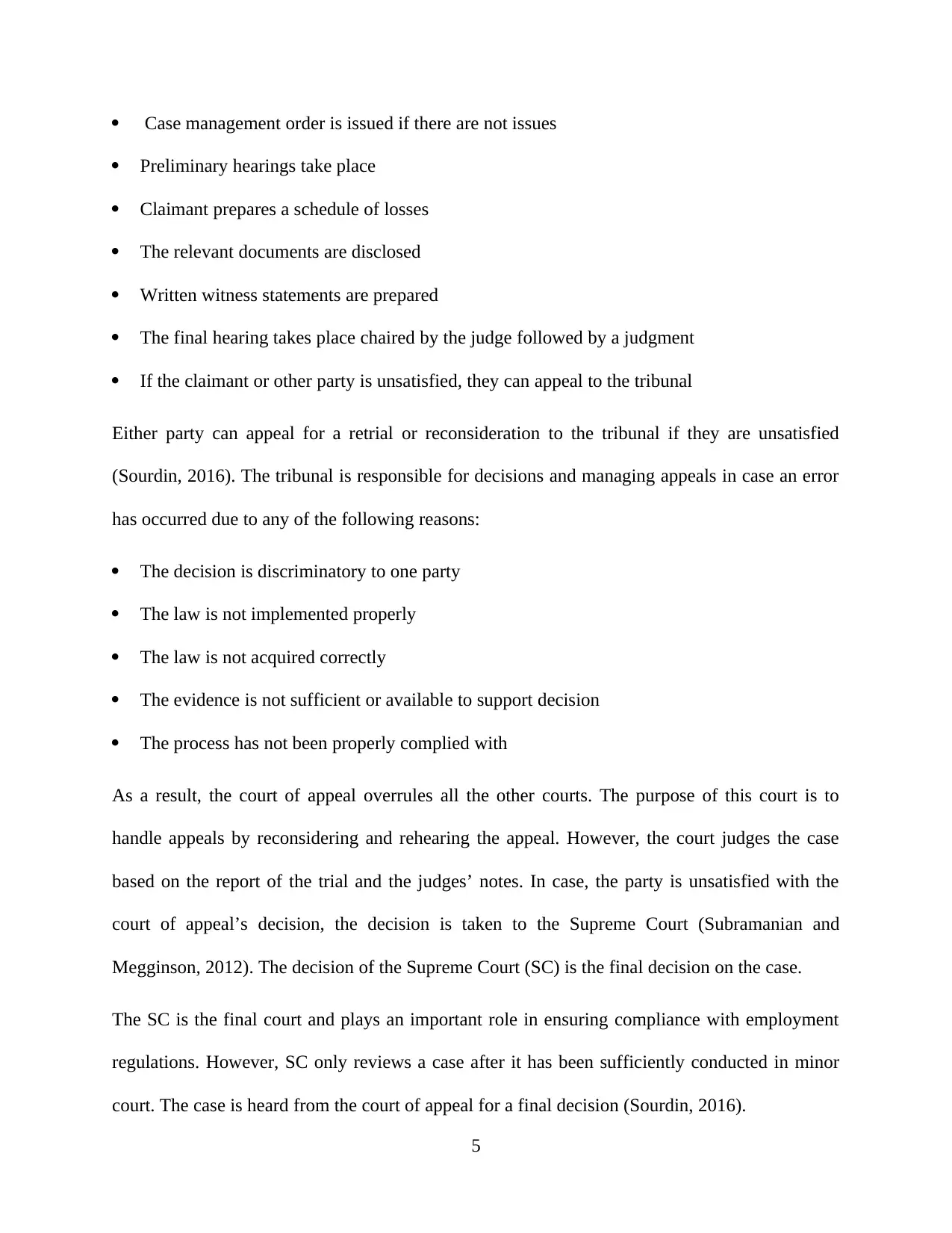
Case management order is issued if there are not issues
Preliminary hearings take place
Claimant prepares a schedule of losses
The relevant documents are disclosed
Written witness statements are prepared
The final hearing takes place chaired by the judge followed by a judgment
If the claimant or other party is unsatisfied, they can appeal to the tribunal
Either party can appeal for a retrial or reconsideration to the tribunal if they are unsatisfied
(Sourdin, 2016). The tribunal is responsible for decisions and managing appeals in case an error
has occurred due to any of the following reasons:
The decision is discriminatory to one party
The law is not implemented properly
The law is not acquired correctly
The evidence is not sufficient or available to support decision
The process has not been properly complied with
As a result, the court of appeal overrules all the other courts. The purpose of this court is to
handle appeals by reconsidering and rehearing the appeal. However, the court judges the case
based on the report of the trial and the judges’ notes. In case, the party is unsatisfied with the
court of appeal’s decision, the decision is taken to the Supreme Court (Subramanian and
Megginson, 2012). The decision of the Supreme Court (SC) is the final decision on the case.
The SC is the final court and plays an important role in ensuring compliance with employment
regulations. However, SC only reviews a case after it has been sufficiently conducted in minor
court. The case is heard from the court of appeal for a final decision (Sourdin, 2016).
5
Preliminary hearings take place
Claimant prepares a schedule of losses
The relevant documents are disclosed
Written witness statements are prepared
The final hearing takes place chaired by the judge followed by a judgment
If the claimant or other party is unsatisfied, they can appeal to the tribunal
Either party can appeal for a retrial or reconsideration to the tribunal if they are unsatisfied
(Sourdin, 2016). The tribunal is responsible for decisions and managing appeals in case an error
has occurred due to any of the following reasons:
The decision is discriminatory to one party
The law is not implemented properly
The law is not acquired correctly
The evidence is not sufficient or available to support decision
The process has not been properly complied with
As a result, the court of appeal overrules all the other courts. The purpose of this court is to
handle appeals by reconsidering and rehearing the appeal. However, the court judges the case
based on the report of the trial and the judges’ notes. In case, the party is unsatisfied with the
court of appeal’s decision, the decision is taken to the Supreme Court (Subramanian and
Megginson, 2012). The decision of the Supreme Court (SC) is the final decision on the case.
The SC is the final court and plays an important role in ensuring compliance with employment
regulations. However, SC only reviews a case after it has been sufficiently conducted in minor
court. The case is heard from the court of appeal for a final decision (Sourdin, 2016).
5
⊘ This is a preview!⊘
Do you want full access?
Subscribe today to unlock all pages.

Trusted by 1+ million students worldwide
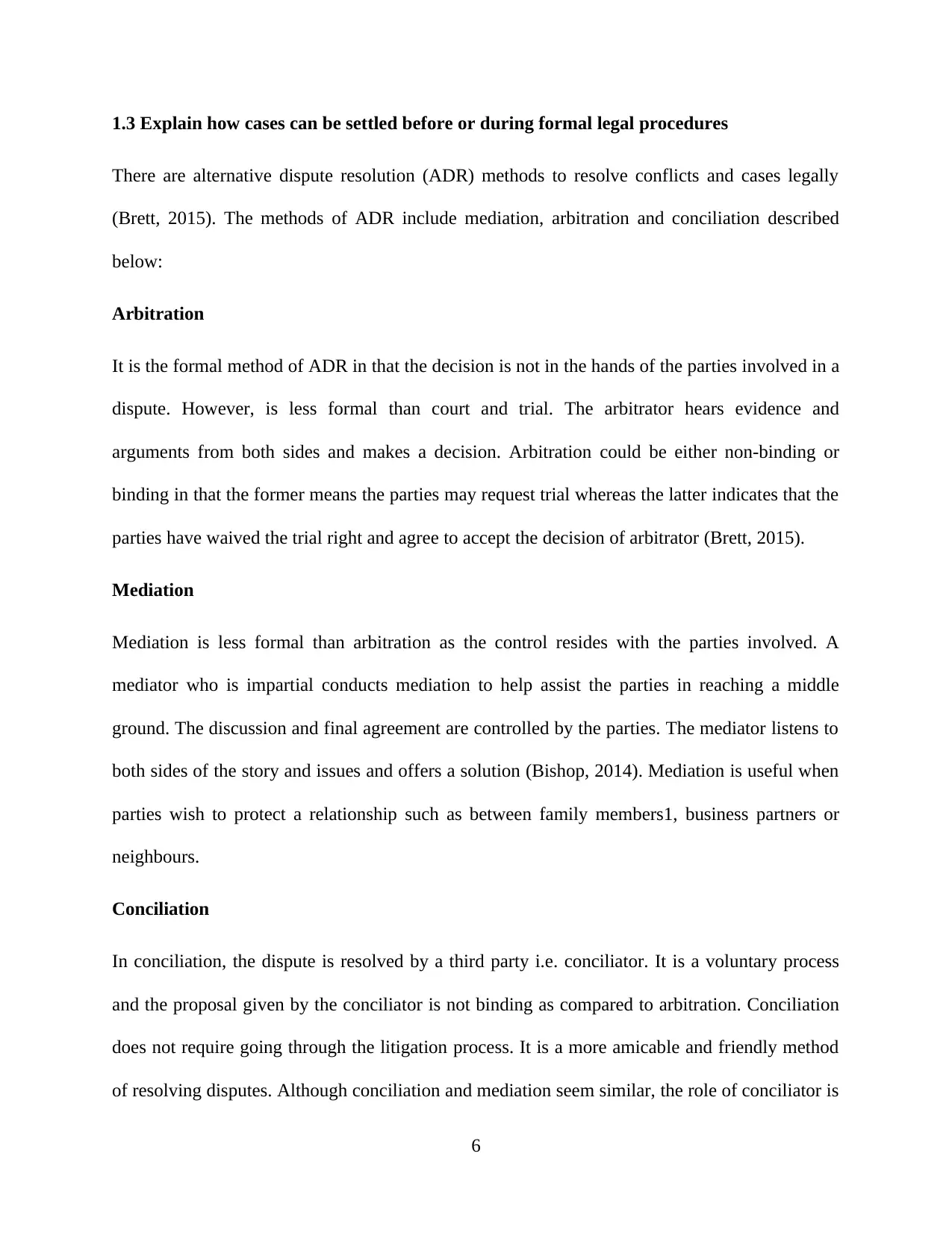
1.3 Explain how cases can be settled before or during formal legal procedures
There are alternative dispute resolution (ADR) methods to resolve conflicts and cases legally
(Brett, 2015). The methods of ADR include mediation, arbitration and conciliation described
below:
Arbitration
It is the formal method of ADR in that the decision is not in the hands of the parties involved in a
dispute. However, is less formal than court and trial. The arbitrator hears evidence and
arguments from both sides and makes a decision. Arbitration could be either non-binding or
binding in that the former means the parties may request trial whereas the latter indicates that the
parties have waived the trial right and agree to accept the decision of arbitrator (Brett, 2015).
Mediation
Mediation is less formal than arbitration as the control resides with the parties involved. A
mediator who is impartial conducts mediation to help assist the parties in reaching a middle
ground. The discussion and final agreement are controlled by the parties. The mediator listens to
both sides of the story and issues and offers a solution (Bishop, 2014). Mediation is useful when
parties wish to protect a relationship such as between family members1, business partners or
neighbours.
Conciliation
In conciliation, the dispute is resolved by a third party i.e. conciliator. It is a voluntary process
and the proposal given by the conciliator is not binding as compared to arbitration. Conciliation
does not require going through the litigation process. It is a more amicable and friendly method
of resolving disputes. Although conciliation and mediation seem similar, the role of conciliator is
6
There are alternative dispute resolution (ADR) methods to resolve conflicts and cases legally
(Brett, 2015). The methods of ADR include mediation, arbitration and conciliation described
below:
Arbitration
It is the formal method of ADR in that the decision is not in the hands of the parties involved in a
dispute. However, is less formal than court and trial. The arbitrator hears evidence and
arguments from both sides and makes a decision. Arbitration could be either non-binding or
binding in that the former means the parties may request trial whereas the latter indicates that the
parties have waived the trial right and agree to accept the decision of arbitrator (Brett, 2015).
Mediation
Mediation is less formal than arbitration as the control resides with the parties involved. A
mediator who is impartial conducts mediation to help assist the parties in reaching a middle
ground. The discussion and final agreement are controlled by the parties. The mediator listens to
both sides of the story and issues and offers a solution (Bishop, 2014). Mediation is useful when
parties wish to protect a relationship such as between family members1, business partners or
neighbours.
Conciliation
In conciliation, the dispute is resolved by a third party i.e. conciliator. It is a voluntary process
and the proposal given by the conciliator is not binding as compared to arbitration. Conciliation
does not require going through the litigation process. It is a more amicable and friendly method
of resolving disputes. Although conciliation and mediation seem similar, the role of conciliator is
6
Paraphrase This Document
Need a fresh take? Get an instant paraphrase of this document with our AI Paraphraser
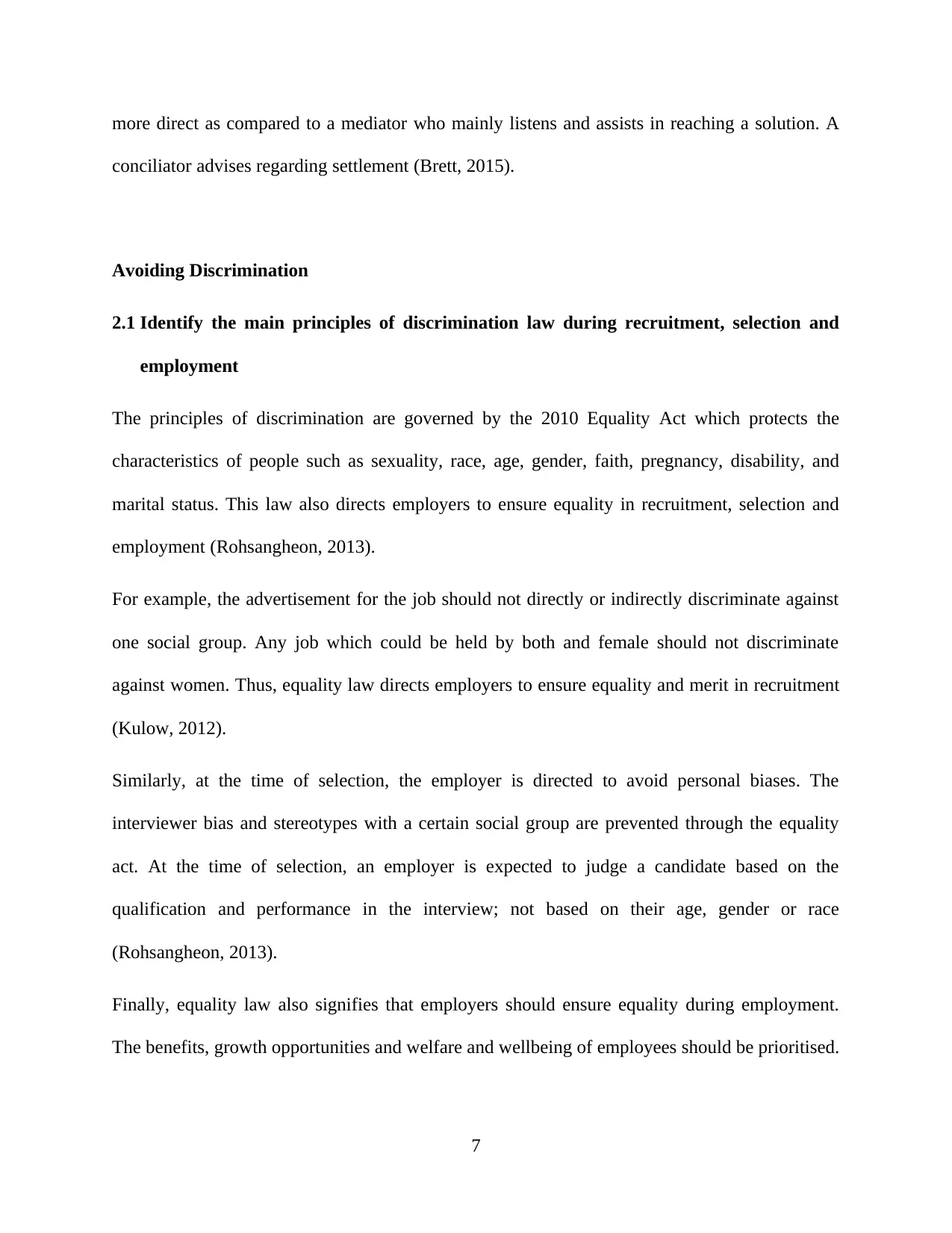
more direct as compared to a mediator who mainly listens and assists in reaching a solution. A
conciliator advises regarding settlement (Brett, 2015).
Avoiding Discrimination
2.1 Identify the main principles of discrimination law during recruitment, selection and
employment
The principles of discrimination are governed by the 2010 Equality Act which protects the
characteristics of people such as sexuality, race, age, gender, faith, pregnancy, disability, and
marital status. This law also directs employers to ensure equality in recruitment, selection and
employment (Rohsangheon, 2013).
For example, the advertisement for the job should not directly or indirectly discriminate against
one social group. Any job which could be held by both and female should not discriminate
against women. Thus, equality law directs employers to ensure equality and merit in recruitment
(Kulow, 2012).
Similarly, at the time of selection, the employer is directed to avoid personal biases. The
interviewer bias and stereotypes with a certain social group are prevented through the equality
act. At the time of selection, an employer is expected to judge a candidate based on the
qualification and performance in the interview; not based on their age, gender or race
(Rohsangheon, 2013).
Finally, equality law also signifies that employers should ensure equality during employment.
The benefits, growth opportunities and welfare and wellbeing of employees should be prioritised.
7
conciliator advises regarding settlement (Brett, 2015).
Avoiding Discrimination
2.1 Identify the main principles of discrimination law during recruitment, selection and
employment
The principles of discrimination are governed by the 2010 Equality Act which protects the
characteristics of people such as sexuality, race, age, gender, faith, pregnancy, disability, and
marital status. This law also directs employers to ensure equality in recruitment, selection and
employment (Rohsangheon, 2013).
For example, the advertisement for the job should not directly or indirectly discriminate against
one social group. Any job which could be held by both and female should not discriminate
against women. Thus, equality law directs employers to ensure equality and merit in recruitment
(Kulow, 2012).
Similarly, at the time of selection, the employer is directed to avoid personal biases. The
interviewer bias and stereotypes with a certain social group are prevented through the equality
act. At the time of selection, an employer is expected to judge a candidate based on the
qualification and performance in the interview; not based on their age, gender or race
(Rohsangheon, 2013).
Finally, equality law also signifies that employers should ensure equality during employment.
The benefits, growth opportunities and welfare and wellbeing of employees should be prioritised.
7
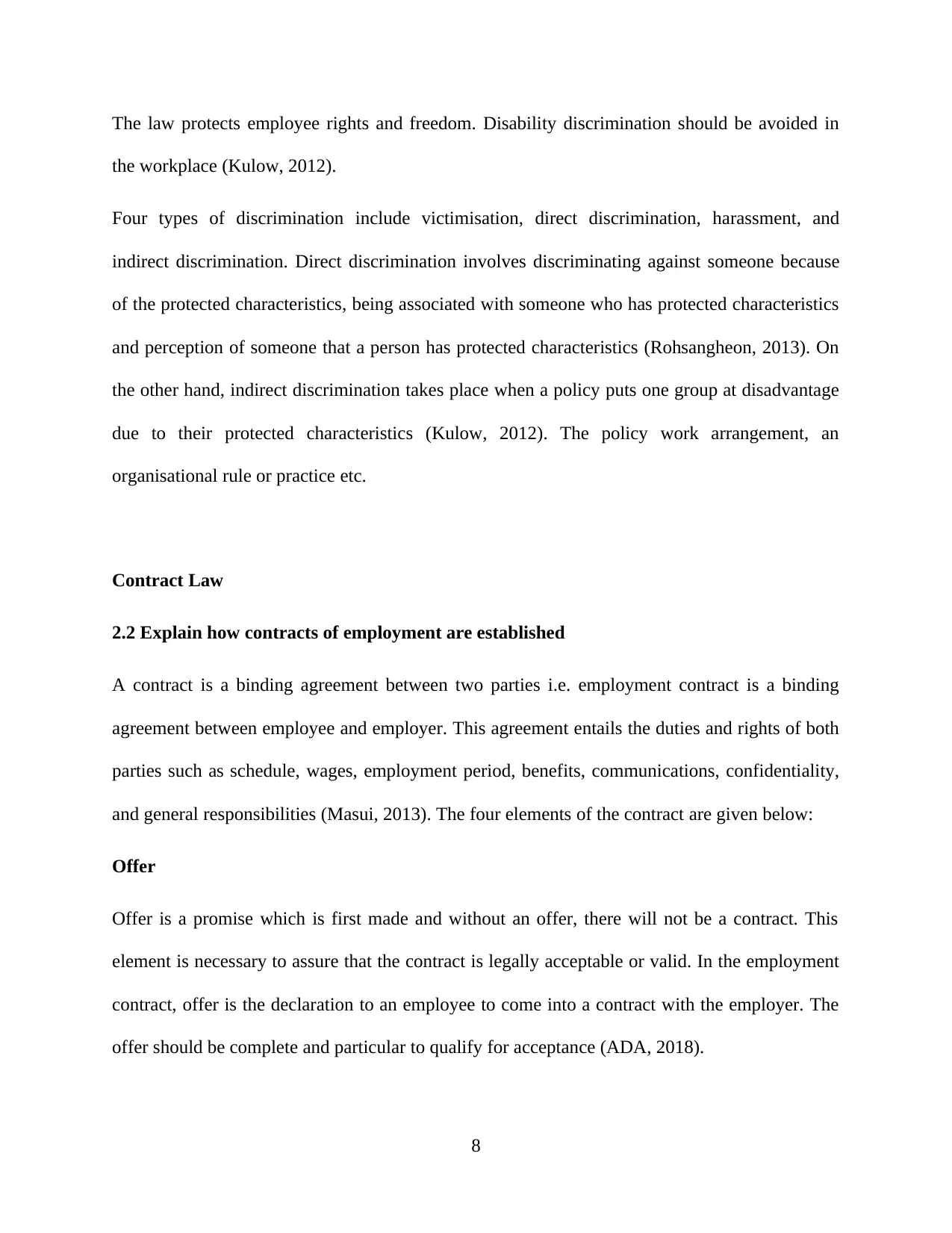
The law protects employee rights and freedom. Disability discrimination should be avoided in
the workplace (Kulow, 2012).
Four types of discrimination include victimisation, direct discrimination, harassment, and
indirect discrimination. Direct discrimination involves discriminating against someone because
of the protected characteristics, being associated with someone who has protected characteristics
and perception of someone that a person has protected characteristics (Rohsangheon, 2013). On
the other hand, indirect discrimination takes place when a policy puts one group at disadvantage
due to their protected characteristics (Kulow, 2012). The policy work arrangement, an
organisational rule or practice etc.
Contract Law
2.2 Explain how contracts of employment are established
A contract is a binding agreement between two parties i.e. employment contract is a binding
agreement between employee and employer. This agreement entails the duties and rights of both
parties such as schedule, wages, employment period, benefits, communications, confidentiality,
and general responsibilities (Masui, 2013). The four elements of the contract are given below:
Offer
Offer is a promise which is first made and without an offer, there will not be a contract. This
element is necessary to assure that the contract is legally acceptable or valid. In the employment
contract, offer is the declaration to an employee to come into a contract with the employer. The
offer should be complete and particular to qualify for acceptance (ADA, 2018).
8
the workplace (Kulow, 2012).
Four types of discrimination include victimisation, direct discrimination, harassment, and
indirect discrimination. Direct discrimination involves discriminating against someone because
of the protected characteristics, being associated with someone who has protected characteristics
and perception of someone that a person has protected characteristics (Rohsangheon, 2013). On
the other hand, indirect discrimination takes place when a policy puts one group at disadvantage
due to their protected characteristics (Kulow, 2012). The policy work arrangement, an
organisational rule or practice etc.
Contract Law
2.2 Explain how contracts of employment are established
A contract is a binding agreement between two parties i.e. employment contract is a binding
agreement between employee and employer. This agreement entails the duties and rights of both
parties such as schedule, wages, employment period, benefits, communications, confidentiality,
and general responsibilities (Masui, 2013). The four elements of the contract are given below:
Offer
Offer is a promise which is first made and without an offer, there will not be a contract. This
element is necessary to assure that the contract is legally acceptable or valid. In the employment
contract, offer is the declaration to an employee to come into a contract with the employer. The
offer should be complete and particular to qualify for acceptance (ADA, 2018).
8
⊘ This is a preview!⊘
Do you want full access?
Subscribe today to unlock all pages.

Trusted by 1+ million students worldwide
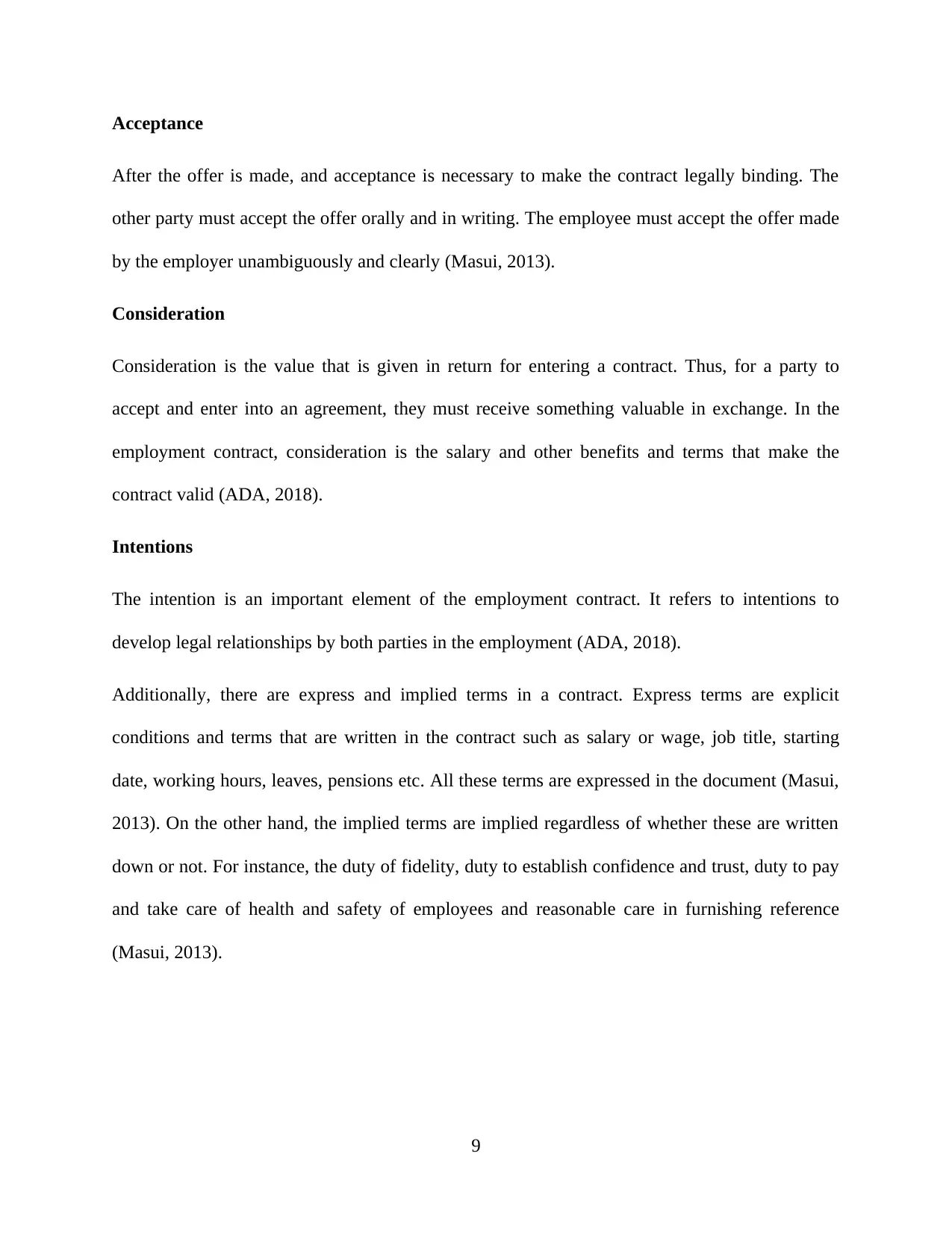
Acceptance
After the offer is made, and acceptance is necessary to make the contract legally binding. The
other party must accept the offer orally and in writing. The employee must accept the offer made
by the employer unambiguously and clearly (Masui, 2013).
Consideration
Consideration is the value that is given in return for entering a contract. Thus, for a party to
accept and enter into an agreement, they must receive something valuable in exchange. In the
employment contract, consideration is the salary and other benefits and terms that make the
contract valid (ADA, 2018).
Intentions
The intention is an important element of the employment contract. It refers to intentions to
develop legal relationships by both parties in the employment (ADA, 2018).
Additionally, there are express and implied terms in a contract. Express terms are explicit
conditions and terms that are written in the contract such as salary or wage, job title, starting
date, working hours, leaves, pensions etc. All these terms are expressed in the document (Masui,
2013). On the other hand, the implied terms are implied regardless of whether these are written
down or not. For instance, the duty of fidelity, duty to establish confidence and trust, duty to pay
and take care of health and safety of employees and reasonable care in furnishing reference
(Masui, 2013).
9
After the offer is made, and acceptance is necessary to make the contract legally binding. The
other party must accept the offer orally and in writing. The employee must accept the offer made
by the employer unambiguously and clearly (Masui, 2013).
Consideration
Consideration is the value that is given in return for entering a contract. Thus, for a party to
accept and enter into an agreement, they must receive something valuable in exchange. In the
employment contract, consideration is the salary and other benefits and terms that make the
contract valid (ADA, 2018).
Intentions
The intention is an important element of the employment contract. It refers to intentions to
develop legal relationships by both parties in the employment (ADA, 2018).
Additionally, there are express and implied terms in a contract. Express terms are explicit
conditions and terms that are written in the contract such as salary or wage, job title, starting
date, working hours, leaves, pensions etc. All these terms are expressed in the document (Masui,
2013). On the other hand, the implied terms are implied regardless of whether these are written
down or not. For instance, the duty of fidelity, duty to establish confidence and trust, duty to pay
and take care of health and safety of employees and reasonable care in furnishing reference
(Masui, 2013).
9
Paraphrase This Document
Need a fresh take? Get an instant paraphrase of this document with our AI Paraphraser
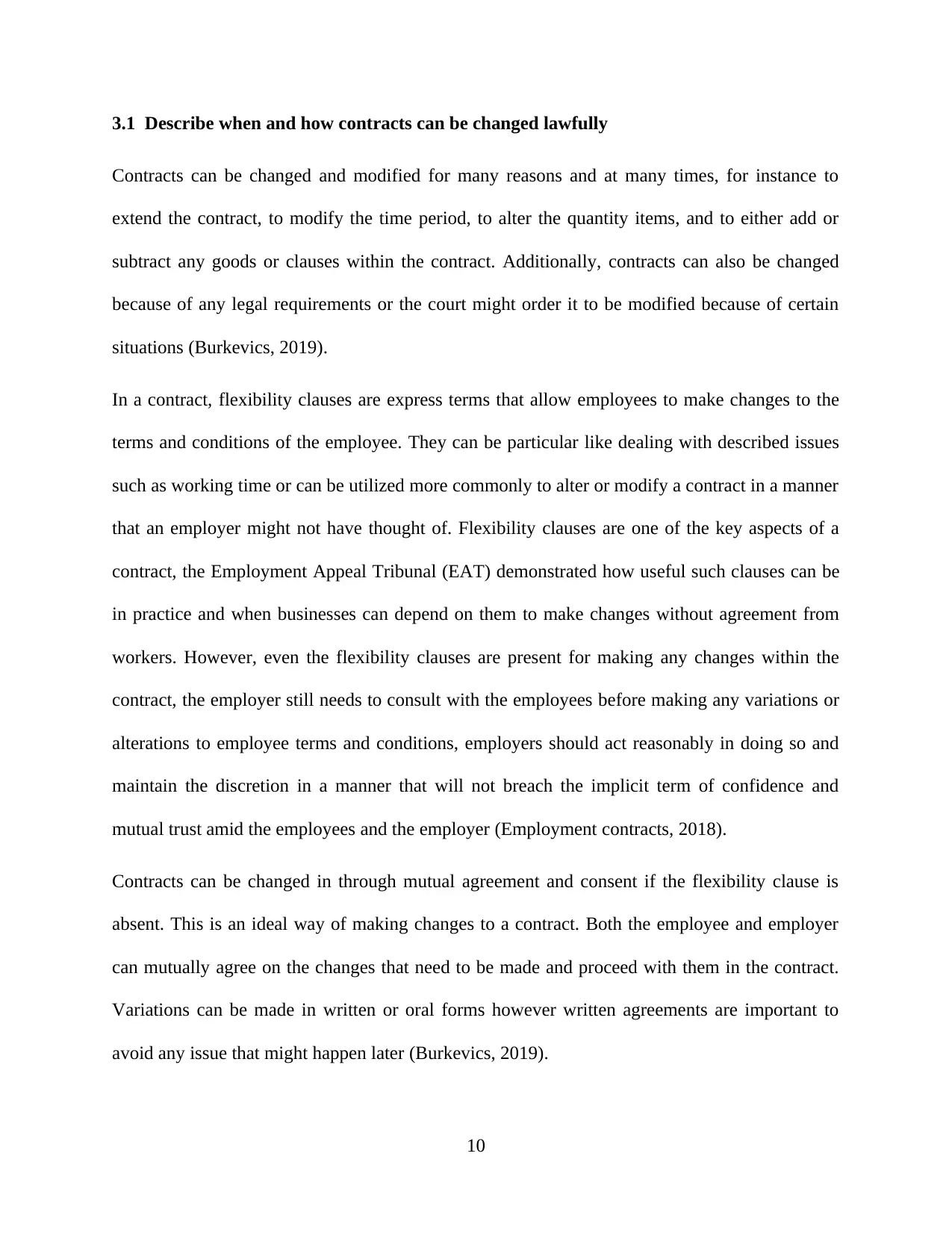
3.1 Describe when and how contracts can be changed lawfully
Contracts can be changed and modified for many reasons and at many times, for instance to
extend the contract, to modify the time period, to alter the quantity items, and to either add or
subtract any goods or clauses within the contract. Additionally, contracts can also be changed
because of any legal requirements or the court might order it to be modified because of certain
situations (Burkevics, 2019).
In a contract, flexibility clauses are express terms that allow employees to make changes to the
terms and conditions of the employee. They can be particular like dealing with described issues
such as working time or can be utilized more commonly to alter or modify a contract in a manner
that an employer might not have thought of. Flexibility clauses are one of the key aspects of a
contract, the Employment Appeal Tribunal (EAT) demonstrated how useful such clauses can be
in practice and when businesses can depend on them to make changes without agreement from
workers. However, even the flexibility clauses are present for making any changes within the
contract, the employer still needs to consult with the employees before making any variations or
alterations to employee terms and conditions, employers should act reasonably in doing so and
maintain the discretion in a manner that will not breach the implicit term of confidence and
mutual trust amid the employees and the employer (Employment contracts, 2018).
Contracts can be changed in through mutual agreement and consent if the flexibility clause is
absent. This is an ideal way of making changes to a contract. Both the employee and employer
can mutually agree on the changes that need to be made and proceed with them in the contract.
Variations can be made in written or oral forms however written agreements are important to
avoid any issue that might happen later (Burkevics, 2019).
10
Contracts can be changed and modified for many reasons and at many times, for instance to
extend the contract, to modify the time period, to alter the quantity items, and to either add or
subtract any goods or clauses within the contract. Additionally, contracts can also be changed
because of any legal requirements or the court might order it to be modified because of certain
situations (Burkevics, 2019).
In a contract, flexibility clauses are express terms that allow employees to make changes to the
terms and conditions of the employee. They can be particular like dealing with described issues
such as working time or can be utilized more commonly to alter or modify a contract in a manner
that an employer might not have thought of. Flexibility clauses are one of the key aspects of a
contract, the Employment Appeal Tribunal (EAT) demonstrated how useful such clauses can be
in practice and when businesses can depend on them to make changes without agreement from
workers. However, even the flexibility clauses are present for making any changes within the
contract, the employer still needs to consult with the employees before making any variations or
alterations to employee terms and conditions, employers should act reasonably in doing so and
maintain the discretion in a manner that will not breach the implicit term of confidence and
mutual trust amid the employees and the employer (Employment contracts, 2018).
Contracts can be changed in through mutual agreement and consent if the flexibility clause is
absent. This is an ideal way of making changes to a contract. Both the employee and employer
can mutually agree on the changes that need to be made and proceed with them in the contract.
Variations can be made in written or oral forms however written agreements are important to
avoid any issue that might happen later (Burkevics, 2019).
10
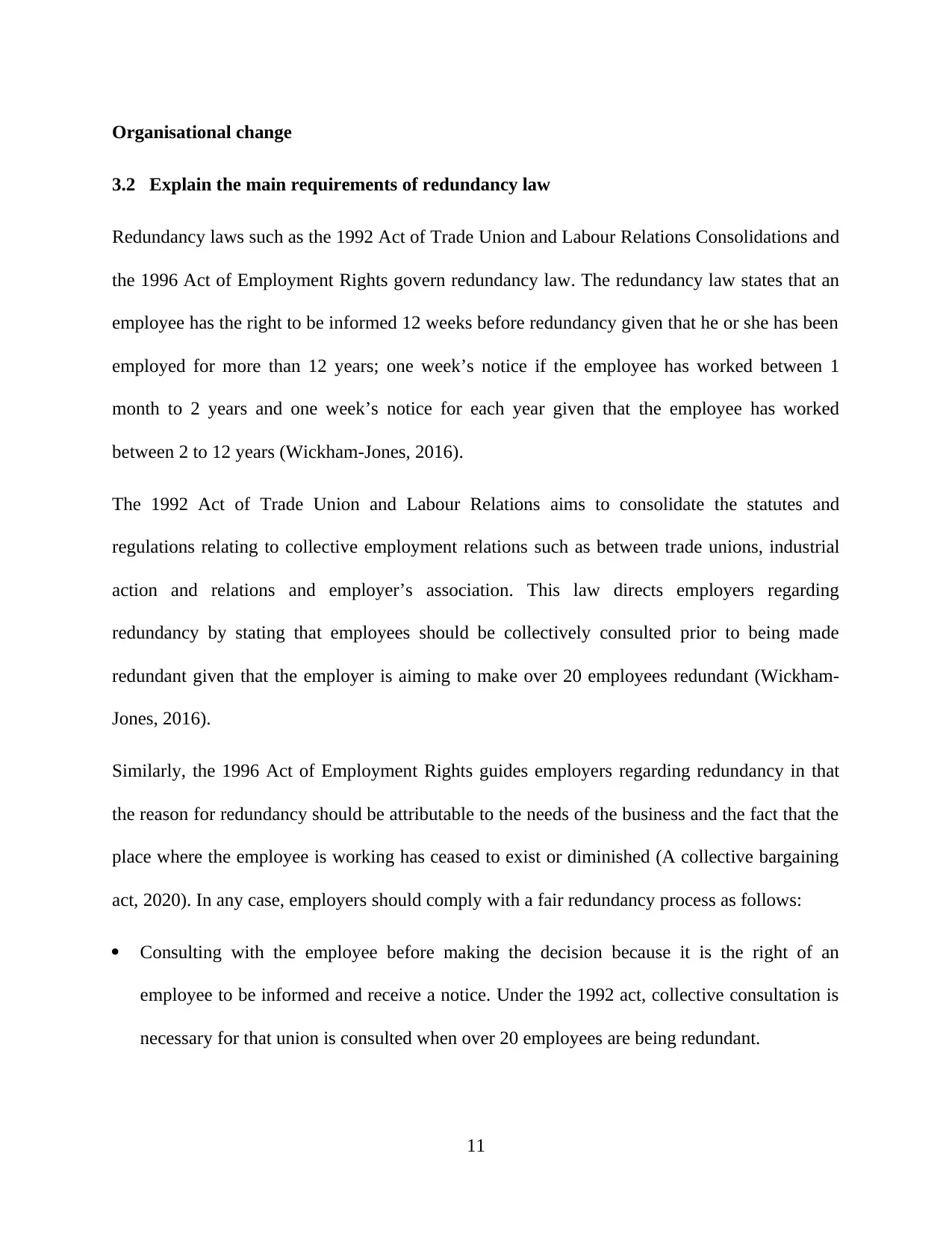
Organisational change
3.2 Explain the main requirements of redundancy law
Redundancy laws such as the 1992 Act of Trade Union and Labour Relations Consolidations and
the 1996 Act of Employment Rights govern redundancy law. The redundancy law states that an
employee has the right to be informed 12 weeks before redundancy given that he or she has been
employed for more than 12 years; one week’s notice if the employee has worked between 1
month to 2 years and one week’s notice for each year given that the employee has worked
between 2 to 12 years (Wickham-Jones, 2016).
The 1992 Act of Trade Union and Labour Relations aims to consolidate the statutes and
regulations relating to collective employment relations such as between trade unions, industrial
action and relations and employer’s association. This law directs employers regarding
redundancy by stating that employees should be collectively consulted prior to being made
redundant given that the employer is aiming to make over 20 employees redundant (Wickham-
Jones, 2016).
Similarly, the 1996 Act of Employment Rights guides employers regarding redundancy in that
the reason for redundancy should be attributable to the needs of the business and the fact that the
place where the employee is working has ceased to exist or diminished (A collective bargaining
act, 2020). In any case, employers should comply with a fair redundancy process as follows:
Consulting with the employee before making the decision because it is the right of an
employee to be informed and receive a notice. Under the 1992 act, collective consultation is
necessary for that union is consulted when over 20 employees are being redundant.
11
3.2 Explain the main requirements of redundancy law
Redundancy laws such as the 1992 Act of Trade Union and Labour Relations Consolidations and
the 1996 Act of Employment Rights govern redundancy law. The redundancy law states that an
employee has the right to be informed 12 weeks before redundancy given that he or she has been
employed for more than 12 years; one week’s notice if the employee has worked between 1
month to 2 years and one week’s notice for each year given that the employee has worked
between 2 to 12 years (Wickham-Jones, 2016).
The 1992 Act of Trade Union and Labour Relations aims to consolidate the statutes and
regulations relating to collective employment relations such as between trade unions, industrial
action and relations and employer’s association. This law directs employers regarding
redundancy by stating that employees should be collectively consulted prior to being made
redundant given that the employer is aiming to make over 20 employees redundant (Wickham-
Jones, 2016).
Similarly, the 1996 Act of Employment Rights guides employers regarding redundancy in that
the reason for redundancy should be attributable to the needs of the business and the fact that the
place where the employee is working has ceased to exist or diminished (A collective bargaining
act, 2020). In any case, employers should comply with a fair redundancy process as follows:
Consulting with the employee before making the decision because it is the right of an
employee to be informed and receive a notice. Under the 1992 act, collective consultation is
necessary for that union is consulted when over 20 employees are being redundant.
11
⊘ This is a preview!⊘
Do you want full access?
Subscribe today to unlock all pages.

Trusted by 1+ million students worldwide
1 out of 29
Related Documents
Your All-in-One AI-Powered Toolkit for Academic Success.
+13062052269
info@desklib.com
Available 24*7 on WhatsApp / Email
![[object Object]](/_next/static/media/star-bottom.7253800d.svg)
Unlock your academic potential
Copyright © 2020–2025 A2Z Services. All Rights Reserved. Developed and managed by ZUCOL.





